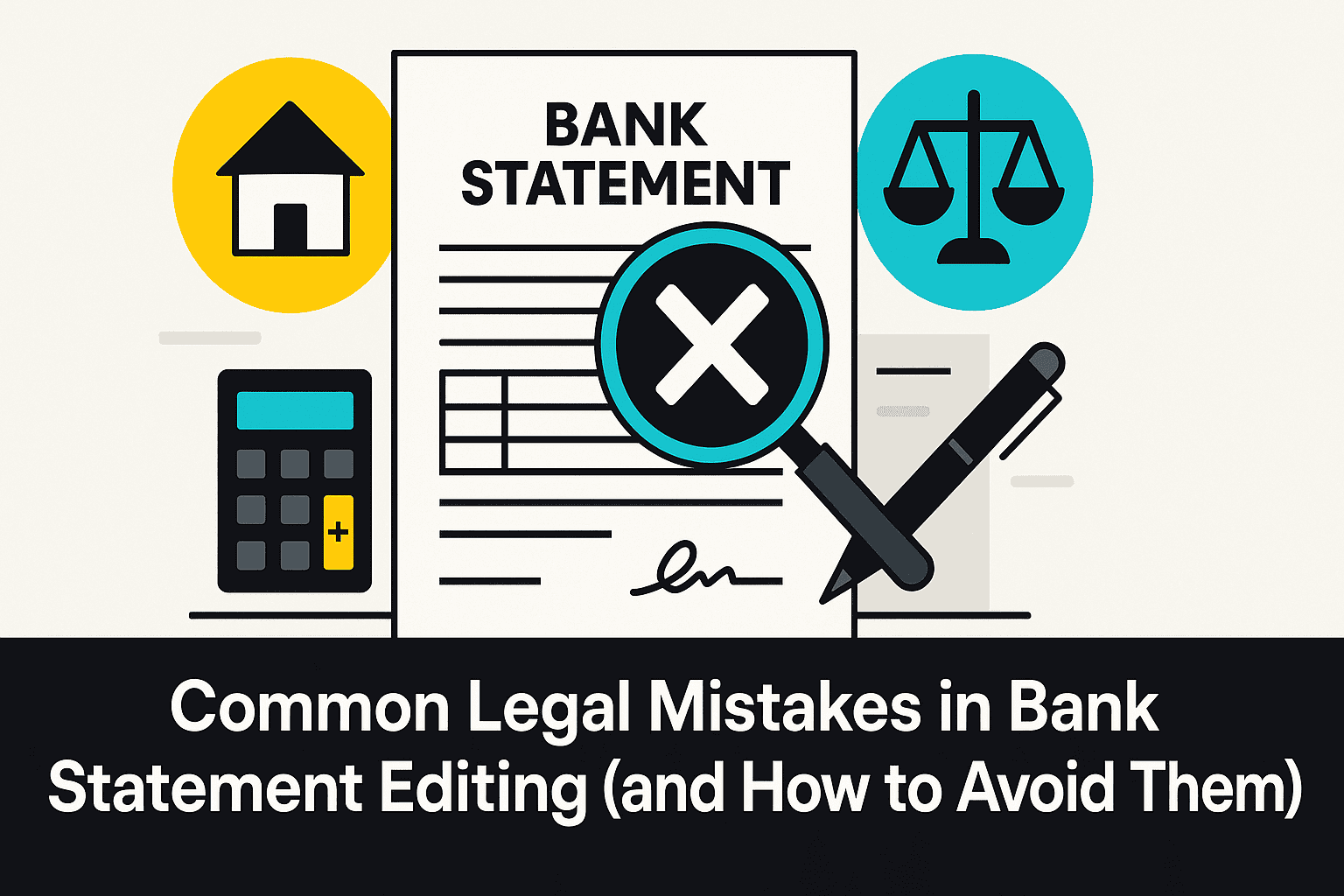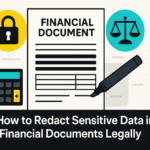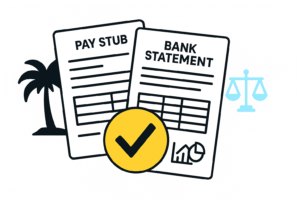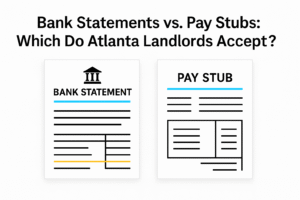Table of Contents
Introduction
Last updated: August 2025
By the FinancialDocsProvider Editorial Team
Bank statement editing legal mistakes usually happen when people confuse harmless formatting with wrongful falsification. If you’re a renter, car-loan applicant, or small-business owner, you may need to organize, compress, or redact statements so reviewers can evaluate your file quickly. That’s lawful when done properly. Changing facts—amounts, dates, payees, or balances—is not. This guide explains the difference, shows what’s allowed in the US, UK, and Canada, and outlines the red flags underwriters watch for so you can avoid delays—or worse, rejections.
- Proof of income (W-2, 1099, payslips, T4, Notice of Assessment/NOA)
- Underwriting, tenant screening, loan processing
- Regulators: CFPB, FTC, IRS (US); FCA & GOV.UK (UK); FCAC & CRA (Canada)
- Electronic Fund Transfers (US Regulation E)
- KYC/AML, source of funds (SOF), source of wealth (SOW)
- PDF redaction, metadata, OCR, file compression
- Statement reconciliation, audit trail, document packaging
- SBA loans, auto financing, landlord income verification
At FinancialDocsProvider.com, our role is simple: we edit/format/organize legitimate documents for clarity and accessibility. We will not fabricate numbers, dates, parties, or pages. If you need help with proof of income editing or bank statement formatting, our team follows a strict, compliance-first workflow.

Legality Basics (US, UK & Canada): Formatting vs. Falsification
United States: Consumer protections & records
In the US, consumer protections focus on the accuracy of your bank’s records and electronic fund transfers. If a transaction is wrong or unauthorized, use your bank’s error-resolution process—don’t “fix” the PDF yourself. Regulation E outlines error-resolution timelines and liability rules for unauthorized transfers; start with your bank and keep a paper trail (CFPB Reg E §1005.11, §1005.6). For taxes and income verification, keep orderly records so you can substantiate entries if asked by the IRS (IRS recordkeeping; how long to keep records).
United Kingdom: Transparency & statement content
UK guidance emphasizes clarity and fair information in retail banking. Firms must present key facts clearly in statements, including interest rates and fees (FCA BCOBS 4.2, BCOBS 4.1). For KYC/AML, bank statements are commonly used to evidence source of funds or verify address when appropriate (see HMRC and supervisory guidance on SOF/SOW). None of this allows a consumer to alter factual content; it governs how banks disclose.
Canada: Banking rights & proof of income
In Canada, the Financial Consumer Protection Framework strengthens your rights as a banking customer and outlines complaint-handling expectations (FCAC: banking rights). For income verification, lenders often request CRA documents such as a Notice of Assessment (CRA: NOA). Again, you may redact sensitive data or fix readability, but changing facts is not permissible.
What Edits Are Allowed (and Helpful)
1) Redaction that protects privacy—without hiding facts
It’s reasonable to hide partial account numbers or redact contact details before sharing a statement with a landlord or broker. Use proper PDF redaction (not a black rectangle over text), and leave visible the data underwriters need: account holder name, bank name, statement period, running balances, and each line item.
2) Readability cleanup
- Fix page rotation, margins, and split/merged lines introduced by scanning.
- Run OCR so names and amounts are searchable and selectable.
- Delete duplicate blank pages; keep original page numbering if present.
- Ensure consistent fonts and legible contrast (no gray-on-gray scans).
3) Export fixes & packaging
- Combine several monthly statements into one bookmarked PDF.
- Compress oversized images to email-friendly PDFs without losing legibility.
- Normalize file names, e.g.,
Lastname_Firstname_Bank_Jan–Mar_2025.pdf.
4) When to file a bank dispute instead of “editing”
If a transaction is missing, duplicated, or unauthorized, the compliant path is a formal dispute with your bank, then resubmitting the corrected bank-issued record. Don’t change the figures yourself. For US consumers, see the CFPB’s Regulation E error-resolution guidance; keep copies of your notices and confirmations. For a practical overview, review our template-driven guide, Bank Statement Error Dispute: Legal Steps + Free Template.
Want hands-off help packaging your file? Explore our financial document services and pricing.
What’s Illegal (and Why)
Altering factual content on a bank statement is a form of misrepresentation and may be treated as fraud. Regulators have brought actions against sellers of fake financial documents, and lenders increasingly use automated checks to spot anomalies. The safest—and fastest—path to approval is transparent, verifiable documentation.
Illegal alterations that cause instant rejections
- Changing balances, deposits, or withdrawals to inflate income
- Editing dates to “move” a deposit into the required period
- Adding or removing pages or line items to create an artificial pattern
- Altering payee names to hide gambling or cash-advance activity
- Replacing bank logos or footers to mimic a different institution
Consequences to expect
- Application denial and institutional blacklisting (internal notes persist)
- Account closures when banks detect document tampering
- Potential civil or criminal exposure in serious cases (e.g., use in loan fraud)
- Collateral damage: landlords or lenders may notify one another of risks
For context, the US Federal Trade Commission has previously shut down operations selling fake financial documents, highlighting the risks and penalties for both sellers and users. Learn more at the FTC’s site (press release and consumer alert).
If you’re unsure whether a change is permissible, stop. Ask the requester what they actually need, or contact our team for guidance on lawful formatting only.
Practical Use Cases (with Mini-Scenarios)
Renters & property managers
Scenario: A renter must show three months of income deposits. We combine each monthly PDF into a single file with bookmarks by month, redact the last digits of the account number, run OCR, and add a cover page listing the total deposit amounts per month. No figures are changed—only the presentation.
Auto loans & captive finance
Scenario: A buyer with uneven gig-income needs a clean, readable history. We correct skewed scans, standardize page margins, and add a brief summary table of visible totals that already appear on the statement. We may also add an index of large deposits by date so an underwriter can find them quickly.
Small-business financing (US) & self-employed packets
SBA-style request: Lenders often ask for business and personal statements plus tax filings. For W-2 earners, that might include a W-2 and pay stubs/payslips. For self-employed clients, compile 1099s, Schedule C or P&L, and bank statements; in Canada, T4/T2125 and a recent CRA NOA; in the UK, SA302 and payslips where applicable. Our team organizes the existing numbers and adds an audit note clarifying that we performed formatting, not content changes.
If you’re deciding between pay stubs and bank statements for a rental or loan, our article Pay Stub vs. Bank Statement explains trade-offs and reviewer expectations.
How We Work: Intake → Reconciliation → Formatting → Delivery
1) Intake
- Secure upload portal; we’ll confirm the requester’s requirements.
- Conflict and compliance check: we decline any request to alter facts.
- We map which months and accounts are needed (personal vs. business).
2) Reconciliation
- We line up statement periods, verify page counts, and check continuity.
- We flag potential bank errors and advise you to dispute them (we do not “fix” amounts).
- We prepare a simple index of what’s included for reviewer convenience.
3) Formatting
- Redaction of sensitive PII while preserving needed context.
- OCR, pagination, bookmarks, table of contents, and file compression.
- Optional cover sheet that summarizes visible totals already in the file.
4) Delivery
- Final PDF with clear file names and an internal audit note about the scope of work.
- We can package adjunct items: pay stubs/payslips, income letters, NOA, or tax forms.
Learn more about our process, explore service options, check pricing, or contact our team.
Quick Compliance Checklist & Packaging Tips
- Confirm requirements with the requester (months, accounts, formats).
- Never change facts. If a number is wrong, file a bank dispute.
- Use true redaction, not drawing tools; preserve needed context.
- OCR and test searchability. Can you search a payee’s name?
- Keep continuity. No missing days; page counts match originals.
- Normalize files. Combine months; add bookmarks and a simple index.
- File naming matters. Use date ranges and bank names in the filename.
- Retain originals. Keep the bank-issued PDFs for your records.
Packaging that reviewers love
- Cover page summarizing which months and accounts are included
- Bookmarks by month, with a short note of total credits for each period
- One PDF per bank; one folder per application
Common Bank Statement Editing Legal Mistakes (Red Flags)
Underwriters, landlords, and compliance teams use a mix of human review and automated tools. These issues commonly trigger rejections or manual escalation:
- Math mismatches: running balances don’t reconcile across pages.
- Inconsistent typography: one page’s font/kerning differs from others.
- Metadata red flags: PDFs showing recent edits to figures or vector text on “scanned” pages.
- Date anomalies: missing weekends/holidays, or a month with an impossible number of days.
- Deposit patterns that look engineered: identical rounded amounts on the same weekday for months.
- Logo or footer inconsistencies: low-resolution logos or misaligned footers.
- Mismatch with tax docs: deposits don’t align with W-2/1099/payslips or CRA NOA totals.
Want to understand how reviewers detect tampering in related documents? See our explainer on how landlords and loan officers detect fake pay stubs.
For fundamentals on what’s allowed and risky, read our Bank Statement Editing & Legal Use guide and our deep dive, Is It Legal to Edit a Bank Statement?
Helpful Resources (Official & Internal)
Official regulators & government guidance
- US — CFPB: Reg E error resolution (§1005.11)
- US — CFPB: Liability for unauthorized transfers (§1005.6)
- US — IRS: Recordkeeping; How long to keep records
- UK — FCA Handbook: BCOBS 4.2 (Statements)
- Canada — FCAC: Banking rights & protections
- Canada — CRA: Notice of Assessment (NOA)
- US — FTC: Fake document sellers (consumer alert)
FinancialDocsProvider resources
FAQs
Is it ever legal to edit a bank statement?
Yes—formatting edits are fine: redacting part of an account number, fixing page order or rotation, running OCR, or combining files. What’s illegal is altering facts (amounts, dates, payees, balances) or adding/removing transactions or pages.
Can I hide parts of my address or account number?
You may redact sensitive PII, but leave intact what reviewers need to verify the account and timeline. Use proper PDF redaction tools so the hidden text can’t be recovered.
How do I fix an error on my statement?
Don’t edit the number. Dispute it with your bank, keep confirmations, and resubmit the corrected bank-issued statement. See the CFPB’s guidance on error resolution and our step-by-step dispute template in this article.
Do landlords prefer pay stubs/payslips or bank statements?
Many ask for both. Pay stubs/payslips prove gross pay; bank statements show deposits and spending patterns. When unsure, ask the requester—or compare pros and cons in our guide.
How long should I keep statements and related records?
Keep financial records long enough to substantiate tax filings and resolve disputes. US readers can follow the IRS guidance on record retention; similar principles apply in the UK and Canada. When in doubt, keep originals and store PDFs securely.
Need accurate, reliable financial documents fast? Contact FinancialDocsProvider.com now.








Add comment